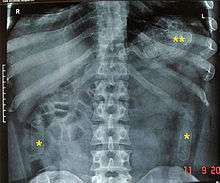Body cavity search

A body cavity search is either a visual search or a manual internal inspection of body cavities for prohibited materials (contraband), such as illegal drugs, money, jewelry, or weapons. Body cavities used for concealment include nostrils, ears, mouth, navel, penis (urethra and foreskin) or vagina, and rectum. It is far more invasive than the standard strip search that is typically performed on individuals taken into custody, either upon police arrest or incarceration at a jail, prison, or psychiatric hospital. Often the procedure is repeated when the person leaves the institution.
Body cavity searches may also be conducted at some international border crossings such as the U.S. Customs and Border Protection when they suspect international travelers of hiding contraband—such as drugs—in their alimentary canal (digestional tract).[1]
Visual vs. manual
Items can be concealed in a number of body cavities. For example, objects may be concealed by inserting them into the rectum. Illegal drugs can be placed in condoms and temporarily stored in the colon. Cylinders such as cigar tubes are used to hide money, intravenous syringes, and knives. Duplicate handcuff keys can be concealed in many body orifices. These goods are considered valuable inside a prison and can pose a security risk to staff and inmates at such facilities.
In a thorough visual body cavity search, a flashlight is used to illuminate body orifices, including nostrils, ears, mouth, navel, penis (urethra and foreskin) or vagina, and rectum. Generally, the detainee is required to manipulate these body parts so that they can be examined.
Squatting is sometimes demanded during visual searches, and prolonged holding of a squat can be demanded; squats are sometimes demanded over a mirror (so that the observer has an improved view). The person may be asked to “squat and cough,” with the aim of dislodging an object stored in the rectum or vagina.[2]
During manual body cavity searches, body orifices are probed using fingers or the entire hand. The circumstance in which these inspections may be done is often restricted. For example, they are done on individuals refusing to offer to consent to a visual body cavity search or in situations where there is strong evidence to suspect the presence of contraband.
The cavity search has proven ineffective in the prevention of smuggling objects as it cannot detect objects in the intestines or stomach. It has become normal for authorities to isolate individuals in a monitored environment until they pass excreta and/or to x-ray the individual as it is less invasive and psychologically damaging.
Legal standing
Some inmates and human rights activists argue that body cavity searches are done not so much to stop the flow of contraband but rather to harass and humiliate detainees. A visual inspection of the rectum will not reveal objects concealed deeply inside. Likewise, it is possible to circumvent detection during manual body cavity searches. In some instances, suspects swallow packages of drugs protected by condoms and allow them to pass through their digestive tract. Only diagnostic imaging will reveal the concealed contraband.

Because these searches are highly invasive and greatly compromise an individual’s right of privacy, the legality of visual and manual body cavity searches is frequently contested.
In the United States, Bell v. Wolfish is the benchmark case on this issue. In its judgment of the case, the U.S. Supreme Court established a standard of reasonable grounds for performing cavity searches. Among these are security concerns at prisons.
In the UK, cavity searches are not carried out upon entry to prisons, although new prisoners are required to perform squats as part of their strip-search, and may be visually searched, but prison staff do not have any powers to carry out cavity searches.[3]
Pakistan
Law enforcement officers are not allowed to conduct cavity searches or strip searches in Pakistan. Any officer who conducts a cavity search or strip search can be sentenced up to 4 years in prison and given a Rs.7500 fine.
In popular culture
The body cavity search is frequently used as a joke in comedies such as the movie Beavis and Butt-head Do America and Seinfeld. This is due to its humiliating, uncomfortable, and invasive nature. Generally, it adds to the suffering of a comedic foil. It is generally not depicted explicitly, but implied by the donning of a lubricated glove by a searcher. It is similar to the use of the rectal examination in this regard.
See also
References
- ↑ See United States v. Montoya de Hernandez, 473 U.S. 531, 538 (1985).
- ↑ http://www.slate.com/articles/news_and_politics/explainer/2012/04/supreme_court_strip_search_decision_how_to_check_someone_for_contraband_.html
- ↑ "Archived copy". Archived from the original on 2011-06-10. Retrieved 2009-06-13.
External links
| Wikimedia Commons has media related to body cavity search. |
- Bell v. Wolfish, 441 U.S. 520, 559 (1979)
- Gochnauer, Myron (1985). "Necessity and Prisoners' Rights.".". New England Journal on Criminal and Civil Confinement. 10: 27–43.
- Kalinich, David B.; Stojkovic, Stan (1985). "Contraband: The Basis for Legitimate Power in a Prison Social System". Criminal Justice and Behavior. 12 (4): 435–451. doi:10.1177/0093854885012004003.
- Lerner, Jimmy (2002). You Got Nothing Coming: Notes From a Prison Fish. New York: Broadway Books.